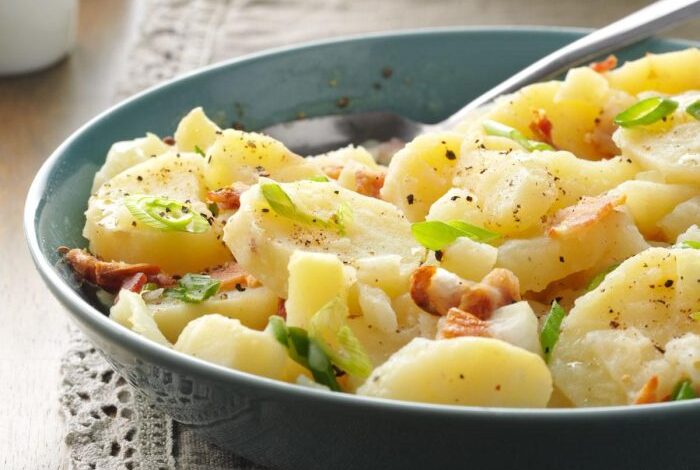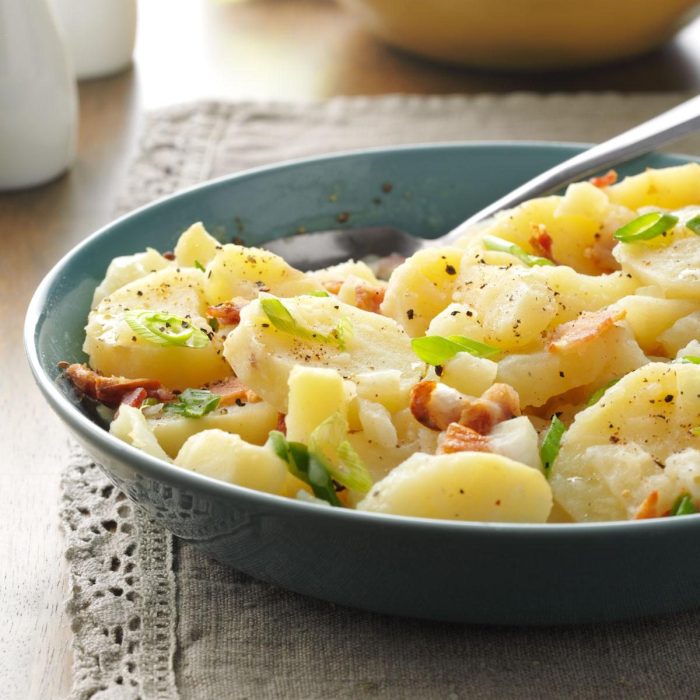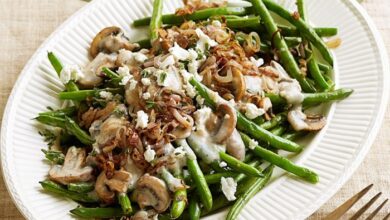
Potato Salad German Kartoffelsalat: A Culinary Journey
Potato Salad German Kartoffelsalat, a dish steeped in history and tradition, is more than just a side dish; it’s a culinary journey through Germany’s rich culinary heritage. This beloved salad, a staple at picnics, family gatherings, and even traditional festivals, boasts a unique flavor profile and a story that’s as captivating as its taste.
From its humble beginnings to its modern-day variations, Kartoffelsalat has evolved alongside German culture, reflecting the country’s love for simple yet flavorful dishes. Whether you’re a seasoned foodie or a curious beginner, exploring the world of German potato salad promises an unforgettable culinary adventure.
The History of German Kartoffelsalat
The history of German Kartoffelsalat is a fascinating journey that reflects the evolution of food culture in Germany. This beloved dish, a simple yet satisfying combination of potatoes, vinegar, and other ingredients, has a rich history intertwined with the development of potato cultivation and the changing culinary landscape of Germany.
Early Origins and Development
The potato, a native of the Andes region of South America, was introduced to Europe in the 16th century. Initially, it was met with skepticism and even suspicion due to its unfamiliar appearance and unknown properties. However, as its nutritional value and versatility became apparent, the potato gradually gained acceptance, particularly in Germany.
By the 18th century, the potato had become a staple food in many parts of Germany, particularly among the lower classes.
- The first documented recipes for potato salad in Germany date back to the 19th century. These early recipes were often simple, consisting of boiled potatoes, vinegar, oil, and seasonings.
- The popularity of potato salad grew rapidly during the 19th century, as it was an affordable and satisfying meal for families and individuals of all socioeconomic backgrounds.
- The Industrial Revolution further contributed to the rise of potato salad, as it provided a convenient and portable meal for workers in factories and mines.
Regional Variations and Influences
Over time, regional variations of Kartoffelsalat emerged, reflecting the diverse culinary traditions and ingredients available in different parts of Germany.
Potato salad, or “Kartoffelsalat” in German, is a classic side dish that’s perfect for picnics and potlucks. While it’s often made with mayonnaise and mustard, there are endless variations. For a spicy kick, try adding some chopped chorizo, which reminds me of the delicious chorizo con huevos spicy Mexican sausage with eggs dish.
The smoky, savory flavor of chorizo complements the creamy potato salad beautifully, adding a touch of warmth and excitement. Whether you’re serving it with grilled meats or enjoying it on its own, potato salad is always a crowd-pleaser.
- In northern Germany, potato salad is often made with a creamy dressing, often incorporating mayonnaise or sour cream.
- In southern Germany, potato salad is typically made with a vinaigrette dressing, often featuring a blend of vinegar, oil, and mustard.
- In some regions, potato salad may also include additional ingredients such as onions, pickles, bacon, or even hard-boiled eggs.
Modern Kartoffelsalat
Today, Kartoffelsalat remains a beloved dish in Germany, enjoyed in homes, restaurants, and at festivals and celebrations. The traditional recipe has evolved over time, with variations reflecting contemporary tastes and culinary influences.
- Modern recipes may incorporate ingredients such as fresh herbs, roasted vegetables, or even exotic spices.
- Kartoffelsalat is often served as a side dish alongside grilled meats, sausages, or fish, but it can also be enjoyed as a main course, particularly when paired with a hearty salad or a side of bread.
Key Ingredients and Variations
German Kartoffelsalat is a versatile dish that can be adapted to personal preferences and regional traditions. While the core ingredients remain consistent, variations in preparation methods and additional components contribute to the diverse flavors and textures of this beloved salad.
Core Ingredients
The foundation of German Kartoffelsalat lies in its essential ingredients:
- Potatoes:The star of the show, potatoes are typically boiled until tender and then cooled. While any potato variety can be used, waxy potatoes hold their shape better after cooking, resulting in a firmer salad.
- Vinegar:A crucial component that provides acidity and balances the richness of the dressing. White wine vinegar or apple cider vinegar are common choices, with apple cider vinegar adding a slightly sweeter note.
- Oil:Vegetable oil, sunflower oil, or rapeseed oil are commonly used to create a creamy dressing.
- Onion:A key flavor enhancer, onions are usually finely diced or sliced and added raw or briefly sautéed.
- Salt and Pepper:Seasoning is essential to bring out the flavors of the other ingredients.
Variations in Ingredients and Preparation
The beauty of Kartoffelsalat lies in its adaptability. Here are some common variations that add unique flavors and textures:
- Bacon or Sausage:Adding crispy bacon or smoked sausage enhances the richness and smokiness of the salad. The bacon or sausage is usually cooked separately and then crumbled or diced into the salad.
- Pickles:Gherkins, dill pickles, or sweet pickles are often added for a tangy and crunchy element. They can be chopped or left whole, depending on personal preference.
- Herbs:Fresh herbs like parsley, chives, or dill add a bright and aromatic touch to the salad. They are usually chopped and stirred in at the end.
- Mustard:A dash of mustard, such as Dijon or whole-grain mustard, adds a pungent kick to the dressing.
- Cream or Sour Cream:For a richer and creamier salad, some recipes call for the addition of cream or sour cream. This creates a more decadent texture and flavor profile.
Regional Differences in Kartoffelsalat Recipes
German Kartoffelsalat boasts regional variations that reflect local culinary traditions and preferences. Here are a few examples:
- Bavarian Kartoffelsalat:Often features a creamy dressing made with mayonnaise and sour cream, along with the addition of sweet pickles and chives.
- Frankfurter Kartoffelsalat:Typically includes cooked frankfurters, diced onions, and a vinegar-based dressing. It is often served warm, making it a hearty and satisfying dish.
- Thuringian Kartoffelsalat:Known for its use of smoked bacon and a tangy vinegar-based dressing. It is often served cold and accompanied by grilled meats or sausages.
Preparation Techniques
The art of making German Kartoffelsalat lies not just in the ingredients, but in the meticulous techniques that bring out its unique character. The careful boiling of potatoes, the creation of a tangy vinaigrette, and the delicate handling of the ingredients all contribute to the final result.
Boiling Potatoes
Boiling potatoes is a crucial step in preparing Kartoffelsalat. The goal is to achieve potatoes that are cooked through but still retain their firmness and texture. Overcooked potatoes will become mushy and lose their shape, while undercooked potatoes will be tough and unpleasant to eat.
- Choosing the right potatoes:The best potatoes for Kartoffelsalat are waxy varieties, such as Yukon Gold or Fingerling potatoes, which hold their shape well during cooking. These potatoes have a higher starch content than starchy potatoes, which helps them to absorb the dressing better.
- Boiling time:The boiling time will depend on the size of the potatoes and the type of potato used. Generally, potatoes should be boiled for 15-20 minutes, or until they are tender when pierced with a fork.
- Cooling the potatoes:After boiling, the potatoes should be immediately drained and cooled to room temperature. This helps to prevent the potatoes from becoming sticky and mushy. You can speed up the cooling process by running cold water over the potatoes or by placing them in a bowl of ice water.
German Kartoffel salad, with its tangy vinegar dressing and crunchy vegetables, is a classic side dish. But sometimes, you crave something a little smoother and richer. That’s where creamy make-ahead mashed potatoes, like the ones featured in this recipe , come in.
The creamy texture of mashed potatoes is a perfect contrast to the sharpness of the Kartoffel salad, making for a delightful combination of flavors and textures.
Making the Vinaigrette
The vinaigrette is the heart and soul of German Kartoffelsalat. It is a simple mixture of oil, vinegar, and seasonings, but it can be customized to suit your taste.
- Oil:The traditional oil used in German Kartoffelsalat is sunflower oil, but you can also use other neutral oils, such as canola oil or vegetable oil.
- Vinegar:The most common vinegar used is apple cider vinegar, which adds a fruity sweetness to the vinaigrette. However, you can also use white vinegar or red wine vinegar.
- Seasonings:The most common seasonings are salt, pepper, and mustard. You can also add other seasonings, such as paprika, onion powder, or garlic powder, to your liking.
A good vinaigrette should be balanced, with a tangy acidity from the vinegar and a richness from the oil. The seasonings should be subtle and enhance the flavor of the potatoes without overpowering them.
Combining the Ingredients, Potato salad german kartoffel
Once the potatoes have cooled and the vinaigrette has been prepared, you can combine the ingredients.
- Dicing the potatoes:The potatoes should be diced into bite-sized pieces. You can use a knife or a food processor to dice the potatoes.
- Adding the dressing:The vinaigrette should be added to the potatoes while they are still warm. This helps the potatoes to absorb the dressing better.
- Mixing the ingredients:Gently mix the potatoes and the vinaigrette together. Be careful not to overmix, as this can cause the potatoes to become mushy.
Cultural Significance and Traditions

Kartoffelsalat is more than just a side dish in German cuisine; it’s a beloved staple that reflects the country’s culinary history and cultural identity. Its presence at various occasions and its enduring popularity are testaments to its significance.
Potato salad, or “Kartoffelsalat” in German, is a staple at any summer barbecue. The creamy, tangy dressing is the perfect complement to grilled meats and sausages. But sometimes, I like to add a little something extra to my potato salad.
For a touch of decadence, I like to top it with a dollop of homemade whipped cream, which I often make using the same technique as a butter flaky pie crust – the key is to keep the butter cold! The combination of creamy potato salad and rich whipped cream is simply irresistible.
Traditional Occasions and Events
Kartoffelsalat’s versatility makes it suitable for a wide range of events, from casual gatherings to formal celebrations. It’s a frequent companion to grilled meats, sausages, and other traditional German dishes, especially during summertime. Here are some occasions where Kartoffelsalat is commonly served:
- Summer Barbecues:Kartoffelsalat is a classic addition to German summer barbecues, providing a refreshing and flavorful counterpoint to grilled meats and sausages. It’s often served alongside other traditional dishes like grilled bratwurst, pork chops, or steaks.
- Oktoberfest:While not as ubiquitous as Schweinshaxe or Maßkrüge, Kartoffelsalat can be found at Oktoberfest celebrations, particularly in the more traditional food stalls. It complements the hearty and rich flavors of Bavarian cuisine.
- Family Gatherings:Kartoffelsalat is a popular dish for family gatherings and potlucks. Its simple preparation and ability to be made ahead of time make it an ideal contribution to shared meals.
- Picnics:The portability and refreshing nature of Kartoffelsalat make it a perfect choice for picnics. It’s often paired with sandwiches, salads, and other picnic staples.
Anecdotes and Stories
Kartoffelsalat has woven itself into the fabric of German culture, inspiring stories and anecdotes that highlight its significance. Here are some examples:
“My grandmother’s Kartoffelsalat was legendary. She had a secret ingredient that she refused to share, but it made her salad truly special. It was always the first dish to disappear at family gatherings.”
“Growing up, Kartoffelsalat was a staple at our Sunday dinners. It was a simple but comforting dish that brought our family together. It was a reminder of the importance of shared meals and family traditions.”
These anecdotes showcase how Kartoffelsalat transcends its culinary role and becomes a symbol of family, tradition, and shared experiences.
Modern Interpretations and Innovations
While the traditional German Kartoffelsalat remains a beloved classic, modern chefs and home cooks are continuously exploring new ways to reinterpret this versatile dish. This has led to a fascinating evolution of the classic recipe, incorporating innovative ingredients, techniques, and flavor profiles.
Contemporary Adaptations
Modern interpretations of Kartoffelsalat often draw inspiration from global cuisines, resulting in unique flavor combinations that pay homage to the original while pushing boundaries.
International Influences
Modern Kartoffelsalat often incorporates ingredients and flavor profiles from different cuisines, creating exciting and unexpected twists on the traditional recipe.
- Asian-inspired Kartoffelsalat:Chefs are experimenting with Asian-inspired flavors, incorporating ingredients like soy sauce, ginger, sesame oil, and chili flakes to create a savory and spicy Kartoffelsalat. This fusion brings a unique depth of flavor and aroma to the dish.
- Mediterranean Kartoffelsalat:The Mediterranean influence adds a touch of brightness and freshness to Kartoffelsalat. Ingredients like sun-dried tomatoes, Kalamata olives, feta cheese, and fresh herbs like oregano and basil create a vibrant and flavorful dish.
- Latin American Kartoffelsalat:Latin American influences introduce vibrant colors and bold flavors. Ingredients like corn, black beans, cilantro, and jalapeños create a zesty and spicy Kartoffelsalat.
Innovative Techniques
Modern chefs are employing innovative techniques to elevate the texture and presentation of Kartoffelsalat.
- Sous Vide Potatoes:The sous vide method, known for its precision and even cooking, ensures perfectly cooked potatoes with a creamy texture.
- Potato Purée:Some chefs create a smooth and velvety Kartoffelsalat by incorporating a potato purée, adding a luxurious and decadent touch to the dish.
- Molecular Gastronomy Techniques:Molecular gastronomy techniques like spherification and emulsification are used to create unique textures and presentations, adding an element of surprise and artistry to Kartoffelsalat.
Innovative Ingredients
Beyond traditional ingredients, modern Kartoffelsalat recipes often feature unexpected additions that enhance flavor and texture.
Unique Additions
Modern Kartoffelsalat often incorporates unique ingredients that add depth of flavor and texture.
- Smoked Paprika:Smoked paprika adds a smoky depth and richness to the dressing, enhancing the overall flavor profile.
- Roasted Garlic:Roasted garlic adds a sweet and savory element to the dressing, complementing the potatoes beautifully.
- Pickled Onions:Pickled onions provide a tangy and crunchy contrast to the creamy potatoes, adding a refreshing element to the dish.
Serving Suggestions and Pairings: Potato Salad German Kartoffel
German Kartoffelsalat is a versatile dish that can be enjoyed as a side dish, a main course, or even as part of a larger spread. Its creamy, tangy flavor profile and hearty texture make it a perfect accompaniment to a wide range of dishes.
Ideal Accompaniments
Kartoffelsalat pairs well with various dishes, offering a balance of flavors and textures.
- Grilled meats: The creamy potato salad contrasts beautifully with the smoky, savory flavors of grilled meats like sausages, bratwurst, pork chops, or chicken.
- Roasted vegetables: The tangy dressing of Kartoffelsalat complements the earthy flavors of roasted vegetables such as asparagus, Brussels sprouts, or carrots.
- Fish dishes: Kartoffelsalat can also be enjoyed with fish dishes, especially those with a slightly acidic sauce, like salmon with lemon butter sauce or trout with dill sauce.
Beverage Pairings
The choice of beverage depends on the specific ingredients and flavors of the Kartoffelsalat.
- Traditional German beers: A light and refreshing lager or a crisp pilsner is a classic pairing for Kartoffelsalat, especially when served with grilled meats.
- White wine: A dry Riesling or a Sauvignon Blanc complements the tangy dressing and the potato’s subtle sweetness.
- Sparkling water: For a lighter option, sparkling water with a squeeze of lemon or lime can cleanse the palate and enhance the flavors of the salad.
Role in a Complete Meal
Kartoffelsalat can play a variety of roles in a complete meal, depending on the occasion and the desired balance of flavors.
- Side dish: It can be a classic side dish for a barbecue, picnic, or family dinner, adding a creamy and flavorful element to the meal.
- Main course: With the addition of protein, such as grilled sausages or smoked salmon, Kartoffelsalat can be a satisfying and hearty main course.
- Part of a buffet: It can be a centerpiece of a buffet, providing a comforting and familiar element alongside other dishes.






